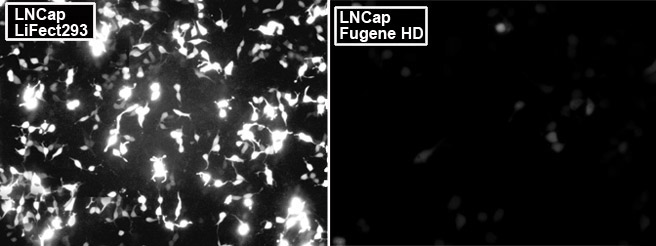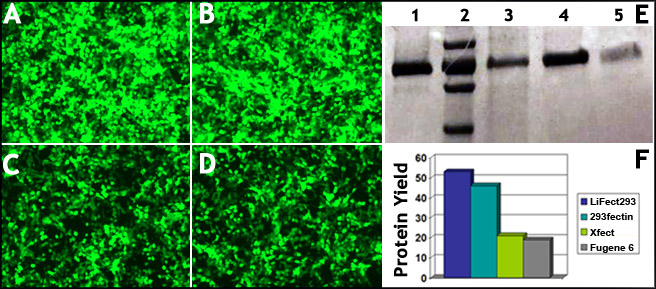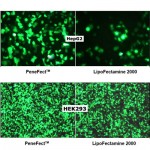Engineered with proprietary lipid-nanoparticle conjugation technology, LiFect293™ transfection reagent represents a next-generation transfection reagent specifically optimized for plasmid transfection in HEK293 lineages and diverse mammalian cell systems. This serum-compatible liposomal formulation integrates novel chemical enhancers that achieve 3-4× higher gene delivery efficiency compared to conventional reagents, while maintaining <15% cytotoxicity in prolonged culture.
Key Features
• Unmatched Viral Packaging: Enables lentivirus titers >1×10^8 TU/mL through optimized transfection protocol workflows.
• Megaplasmid Competence: Consistent transfection efficiency for large constructs (up to 180 kb) in adherent & suspension systems (293F/293H).
• Co-transfection Precision: Maintains >90% plasmid transfection equivalence across multiple DNA combinations.
• Process Flexibility: Serum/antibiotic tolerance allows uninterrupted transfection protocol execution in complex media.
Applications
293 cells transfection
Component
1. LiFect293™ Transfection Reagent: 4 ml
Storage
Store at 4°C.
Applications
293 cell transfection
Component
1. LiFect293™ Transfection Reagent: 1 ml
Storage
At 4°C
Other Size
| Product Name | Cat. # | Price | View |
| LiFect293™ Transfection Reagent (1 ml) | M0002-01 | $199 |
Case Study

A comparison of transfection efficiency of LiFect293™ reagent with lipofectamine 2000 (L2K) on a hard-to-transfect cell, primary rat aortic smooth muscle cells.
The rat aortic smooth muscle cells were prepared and transfected with pEGFP-N3 by LiFect293™ reagent (left panel) and Lipofecatmine 2000 (L2K, right panel) respectively per manufacturers' protocols. The transfection efficiency was evaluated by detecting GFP fluorescence with a Nikon Eclipse 2000 microscopy 24 hours post transfection.

A comparison of transfection efficiency of LiFect293™ reagent with Fugene HD on hard-to-transfect cell, LNCap cells.
The LNCap cells were grown as ATCC recommended procedures and co-transfected with pBabe-hygro-SSeCKs (1.5 µg) and pEGFP-N3 (0.5 µg) per well (6 well plate) LiFect293™ reagent (left panel) and Fugene HD (right panel) respectively per manufacturers' protocols. The transfection efficiency was evaluated by detecting GFP fluorescence with a Nikon Eclipse 2000 microscopy 24 hours post transfection.

A comparison of LiFect293™ reagent vs. 293fectin, Xfect and Fugene 6 transfection reagents on protein production with suspension 293F cells.
30 ml of 293F cell cultured in standard culture medium was transfected with pEGFP-6x His plasmid using LiFect293™ Transfection Reagent (20 µg plasmid DNA), 293Fectin (30 µg plasmid DNA), Xfect (30 µg plasmid DNA) and Fugene 6 (30 µg plasmid DNA) per manufacturers' standard transfection protocols. GFP fluorescence was visualized 48 hours post transfection (left panel) with A for LiFect293, B for 293fectin, C for Xfect and D for Fugene 6. The 6x His tagged GFP protein was then purified via Ni-NTA affinity column. 5 µl of 1st elution fraction was resolved on SDS-PAGE followed by Coomassie Brilliant Blue staining (right upper panel E) with the lane 1 for LiFect293, lane 2 for protein marker, lane 3 for Xfect, lane 4 for 293fectin and lane 5 for Fugene 6. The protein yield was quantified via spectrometer (right lower panel F).
Publications
1. Intranasal pediatric parainfluenza virus-vectored SARS-CoV-2 vaccine is protective in monkeys.
Publication: Cell Product: LiFect293™ Transfection Reagent
2. Increased neutralization potency and breadth elicited by a SARS-CoV-2 mRNA vaccine forming virus-like particles.
Publication: PNAS Product: LiFect293™ Transfection Reagent
3. A multiclade env–gag VLP mRNA vaccine elicits tier-2 HIV-1-neutralizing antibodies and reduces the risk of heterologous SHIV infection in macaques.
Publication: Nature Medicine Product: LiFect293™ Transfection Reagent



